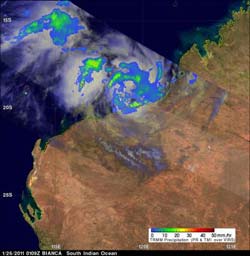NASA's TRMM Satellite sees TD10S strengthen into Tropical Storm Bianca

NASA\'s TRMM satellite captured Tropical Storm Bianca\'s rainfall on Jan. 26. The yellow and green areas indicate moderate rainfall between .78 to 1.57 inches (20 to 340 mm) per hour. Over open waters, in the northwestern quadrant of the storm, there were some areas of heavy rainfall at almost 2 inches (50 mm) per hour. Credit: NASA/SSAI, Hal Pierce<br>
What began as a low pressure system designated as System 98S on January 24, brought rains near Kuri Bay, Australia. On January 25, System 98S strengthened into the tenth tropical depression of the Southern Pacific Ocean hurricane season and was designated as “10S.” Today, January 26, that low intensified into a tropical storm and was named Bianca.
NASA's Tropical Rainfall Measuring Mission (TRMM) satellite has been monitoring rainfall in the storm to assist area forecasters. NASA's TRMM satellite captured Tropical Storm Bianca's rainfall on January 26 at 01:09 UTC (Jan. 25 at 8:09 p.m. EST). Most of the rainfall around the storm was moderate, falling at rates between .78 to 1.57 inches (20 to 340 mm) per hour. Over open waters, in the northwestern quadrant of the storm, there were some areas of heavy rainfall at almost 2 inches (50 mm) per hour. The TRMM image also clearly showed the storm's center was located off the coast and over open waters. The TRMM satellite is managed by both NASA and JAXA, and images are created at NASA's Goddard Space Flight Center in Greenbelt, Md.
On January 26 at 02:20 UTC (Jan. 25 at 9:20 p.m. EST) NASA's Terra satellite passed over Bianca and the Moderate Resolution Spectroradiometer (MODIS) instrument captured an image of Bianca. The image showed a cloud-filled center of circulation just north of the northern coast of Western Australia. Most of the cloud cover associated with Bianca appeared over open waters at that time. The Terra satellite image can be found here. The image was created by NASA's MODIS Rapid Response Team, located at NASA Goddard.
At 1500 UTC (10 a.m. EST) on January 26, Tropical Storm Bianca had maximum sustained winds near 60 knots (69 mph/111 km/hr). It was centered about 225 nautical miles northeast of Learmonth, Australia near 19.8 South latitude and 116.2 East longitude. It was moving westward near 14 knots (16 mph/25 km/hr) and its center was staying off-shore.
Radar imagery from Port Hedland, Australia showed a well-defined low level circulation center with thunderstorms surrounding it. The Joint Typhoon Warning Center forecast indicates that the center of Bianca will stay over open waters as it continues to intensify over the next 24 hours. It is then expected to curve to the southeast and westerly winds are expected to increase and it will move into cooler waters, two factors that will help weaken the storm.
NASA's Hurricane page: www.nasa.gov/hurricane
Media Contact
All latest news from the category: Earth Sciences
Earth Sciences (also referred to as Geosciences), which deals with basic issues surrounding our planet, plays a vital role in the area of energy and raw materials supply.
Earth Sciences comprises subjects such as geology, geography, geological informatics, paleontology, mineralogy, petrography, crystallography, geophysics, geodesy, glaciology, cartography, photogrammetry, meteorology and seismology, early-warning systems, earthquake research and polar research.
Newest articles

High-energy-density aqueous battery based on halogen multi-electron transfer
Traditional non-aqueous lithium-ion batteries have a high energy density, but their safety is compromised due to the flammable organic electrolytes they utilize. Aqueous batteries use water as the solvent for…

First-ever combined heart pump and pig kidney transplant
…gives new hope to patient with terminal illness. Surgeons at NYU Langone Health performed the first-ever combined mechanical heart pump and gene-edited pig kidney transplant surgery in a 54-year-old woman…

Biophysics: Testing how well biomarkers work
LMU researchers have developed a method to determine how reliably target proteins can be labeled using super-resolution fluorescence microscopy. Modern microscopy techniques make it possible to examine the inner workings…





















